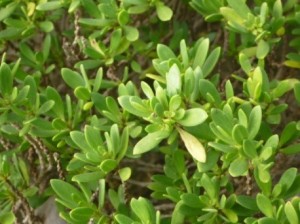Mangroves are unique trees that grow in intertidal areas of subtropical and tropical regions. They are highly specialized in adapting to distinctive environmental conditions they occupy. For instance, some mangroves are able to absorb seawater from the ocean and expel the excess salt through glands on the leaves, while others are able to exclude salt through their roots.
Mangrove Species
As latitude increases diversity of mangrove species decreases. Tonga has a total land area of 720 square kilometers (sq km), whereby only 3.36 sq km are mangroves. So far, only 10 major species of mangroves have been discovered in Tonga. Two of the most common species in Tonga are Rhizophora samoensis and Rhizophora stylosa.
Mangrove Species: Rhizophora stylosa
Most of the information collected is based on studies completed on the main island of Tongatapu. A more recent baseline study on ‘Eua Island near Tongatapu recorded only two main species of mangroves, the Pemphis acidula and Excoecaria agallocha.
Mangrove Species: Pemphis acidula in ‘Eua.
Other islands require identification and distribution studies of mangrove species including Nomuka Island (Ha’apai Group), Vava’u Group, and Niuatoputapu.
Ecological Value of Mangrove Ecosystems
Mangrove ecosystems provide nursery ground for many fish and crustaceans. They also protect shorelines thus reducing erosion, especially in low lying areas with strong wind and storm surges. Additionally, mangroves trap sediment runoff while maintaining water quality and promoting a healthy environment for coral reefs. It is important to recognize that there are no boundaries between mangrove ecosystems, seagrass, and coral reef ecosystems. All of these aquatic ecosystems work together to keep everything in balance between these productive natural systems.
Threats to Mangrove Species
In Tonga, among the most destructive threats facing mangrove species is coastal development. Development is mainly increasing in Vava’u Group and Tongatapu along the periphery of Fanga’uta and Fangkakau Lagoons.
Unsustainable stripping of the mangrove for tannins (a pigment that is used to make dyes) for the tapa making and medicine, and cutting the mangrove for firewood and building materials pose additional threats to the remaining mangrove ecosystems in Tonga.
Threats to Mangroves: Unsustainable stripping ofBruguiera gymnorrhiza.
To address these threats to mangroves, the Environment Division of the Ministry of Lands, Environment, Climate Change, & Natural Resources is conducting awareness programs and actively enforces existing laws promoting sustainable management of mangrove ecosystems in Tonga.
Photos by: 1-3 Hoifua ‘Aholahi



